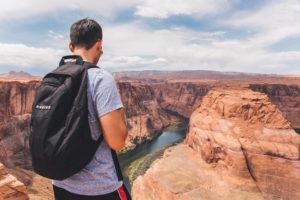While hiking at the Joshua Tree National Park, a 20-year-old man collapsed and died under the immense 120-degree heat. His companion was quick to alert the nearby rangers of their predicament, but they were unable to revive his companion.
Desert hiking can be a dangerous adventure, which is why inexperienced and novice hikers are very much discouraged from attempting them early on.
But how can they be dangerous? What separates it from a normal hike in, say, a forest? This article will examine just that.
Dehydration strikes sooner
It isn’t rocket science to realize that one must always be prepared by bringing with them enough (or more than, even) water to last them throughout a hiking trip, but this applies even more so to deserts.
Deserts can get really hot, and as the temperature intensity increases, your body must work overtime to keep you cool, and it does that by making you sweat. In exchange, however, that means you lose a lot of bodily fluid. The only way you can replenish that is by drinking more water.
What’s more – You must drink water constantly to ensure that you aren’t getting dehydrated. While the feeling of thirst is one way your body informs you that you are lacking in fluid, it is not impossible for your body to become dehydrated without properly informing you and making you thirsty, meaning that waiting for your body to feel thirsty can become dangerous really fast.
You can get a nasty sunburn, or even skin damage
With the sun’s rays going all up in your face in the desert, you are very much exposed to potentially getting a nasty sunburn if your body isn’t well covered or you aren’t properly dressed.
Yes, that means you will need to pack and wear sunscreen for your hikes as though you were going to the beach. Sunlight exposure is sunlight exposure, no matter where you are in the world.
And on the topic of the sun’s rays….
It can get really hot!
And I mean really hot. Deserts can reach up to 100 degrees in terms of temperatures, but some, like the desert mentioned above, can go above and beyond that. That means a higher likelihood of experiencing heat exhaustion, and potentially even overheating while on the trails.
As deserts will not have too much cover to offer, that means possible shaded areas that can protect you from the sun’s rays are limited in number as well.
Poisonous and dangerous wildlife are well-hidden
You’re not the only creature around. Snakes, spiders, and scorpions are also on the trail… Or not too far from it. They are usually hiding themselves in shaded areas, such as tall rock formations and small bushes.
That means that if you wish to take a break, make sure to watch where you are sitting, and to pay attention with both your eyes and your ears! Don’t just touch random places with your hands, especially ones that you haven’t properly examined yet. Snakes are much better at camouflaging themselves than you might think.
Getting poisoned on your hiking trip is the last thing you want happening.
Rock formation and path trails look familiar but are not
Rock formations and bushes aren’t plentiful on desert trails, but they are usually positioned enough to look familiar from a distance, meaning that you might end up getting lost if you mistake them for plants or rocks that you have seen before.
That means you will need to stay alert on the trail and to always carry a map to ensure that you don’t stray too far from the trail. It is actually easier than you might think, especially if you get careless and forget where you are. For instance, areas that feature rocky terrain may have little to no pathing, so there is no telling where you would need to go next once you reach such an area.
Weather patterns can be harsh
Heat waves are usually the most common weather extremities that can be encountered in deserts, owing itself to the natural temperature of the environment. They can be very dangerous, and when one is occurring, it is usually best to avoid desert hiking completely until it fades.
However, don’t just discount the idea of rain or flash floods just yet. Sure, a desert might get 10 inches of rain on average per year, but that does not make them any less likely to be flooded when a storm hits.
This can make places like canyons very dangerous, especially since you will be vulnerable to water and debris from all sides. Those places act like giant drains, which invites things to fall inside of it, and by extension, on top of you.
Wrapping Up
Deserts are usually more dangerous for hikers, especially those who are unprepared and lacking in their equipment. However, this is not meant to discourage people from hiking in the desert, especially when deserts can offer a different hiking experience than your usual trek.
Instead, this article is meant to inform you of what you should watch out for when in the desert, because your priorities will shift compared to that of a forest hike. Take these into account when preparing for your hike, and you will undoubtedly walk out unscathed and with a newfound appreciation for deserts.

